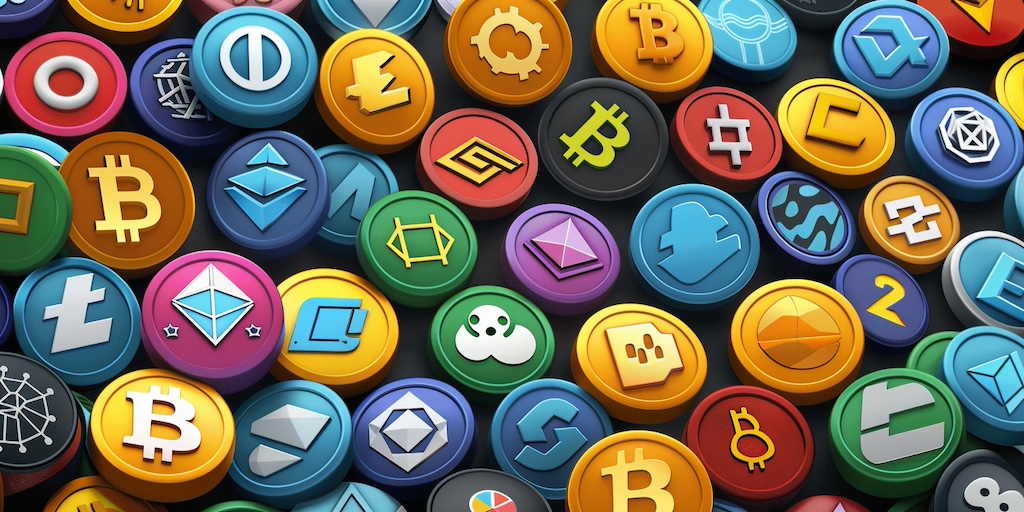There are currently at least 13,000 different cryptocurrency tokens in existence, and by some definitions, that number is far larger. Can all of these new forms of digital money survive? 17th-century London might provide an unexpected answer.

In 2009, money entered a new paradigm with the launch of Bitcoin, a permissionless digital currency based on a blockchain – a distributed ledger – entirely independent of government.
Bitcoin’s success and open-source nature inspired a myriad of blockchain applications with valid real-world use cases, but do we really need thousands of copycat digital tokens, many based on nothing but animal memes?
To help understand the fate of these novel money substitutes, we can go back in time to 17th-century London, where 4,000 unique tokens circulated as a substitute for money but were short-lived.
London’s 17th-century token economy
From the 16th century onwards, the poor state of official coins and the limited supply of small denominations led to the creation of unofficial money substitutes.
England’s money troubles peaked in the 17th century when coin clipping and counterfeiting were so bad that the royal prerogative to create money was suspended.
By some estimates, around 14,000 tokens1 were in circulation nationwide, close to the current level of issuance of modern crypto tokens.
However, by the end of the century, token usage had dwindled, and most of these ancient tokens were dumped in the Thames.
Given surprising similarities in their evolution, understanding the rise and fall of London’s 17th-century tokens can provide valuable clues as to the future of many of their 21st-century counterparts.
Utility is the mother of invention
London’s 17th-century token economy and its strange hybrid forms of money emerged from a combination of necessity and new technology rather than novelty.
We know the idea wasn’t new. The banks of the Tiber in Rome are equally littered with primitive lead tokens called tesserae2.
Merchant tokens were useful for businesses and consumers as a means of exchange, one of the primary functions of money. Demand was driven by the shortcomings and shortfall of official money, the vibrancy of London’s economy and its growing importance relative to Europe.
Coffee shops, for example, weren’t just about recreation; they were crucial venues for sharing knowledge and doing business, nicknamed ‘penny universities’ because of the education you could receive for the price of a cup of joe.
The most famous example of a business that emerged from this fertile mercantile environment is Lloyds of London, the billion-dollar reinsurance marketplace, started as Edward Lloyd’s Coffee House on Tower Street, established around 1688.
The physical limits of London’s tokens
There were thousands of different tokens, despite each providing exactly the same function because trust set a physical limit on their redemption.
Both consumers and merchants had to trust issuers that their tokens would be redeemable at face value with official money.
The Farthing Changer – the equivalent to modern cryptocurrency exchanges – played a key role, enabling the conversion of official money to and from this huge universe of substitutes.
This trust factor effectively limited token usage within the radius of personal relationships, such as a street, a parish, or a small town, creating the need for mini-token economies throughout one of Europe’s largest cities3 and across the country.
Is the creation of crypto tokens driven by necessity?
As with merchant tokens, a new technology (blockchain), rather than better physical presses, has enabled the creation of a new form of money at zero marginal cost, making it trivial to spin up a new cryptocurrency token.
But is the creation of new crypto tokens driven by an equally genuine need for substitute money, as witnessed in 17th-century London?
Bitcoin’s recent all-time high price of close to $74,000 prima facie suggests that there is a clear and continued demand for it as a store of value.
For those willing to read it, the Bitcoin Whitepaper makes a strongly reasoned argument for its usage, including qualities that make it borderless, permissionless, trustless, and especially useful for the unbanked and financially repressed.
However, Bitcoin suffers well-documented scalability issues that alternative blockchain designs are reasonably trying to address.
Unfortunately, the permissionless and censorship-resistant qualities of these new unsanctioned digital mints present a double-edged sword.
The crypto-economy’s speculative nature has produced a Klondike-level rush to pump out tokens with no discernible function other than cashing in on FOMO.
The spectre of speculative value
London’s merchant tokens were limited in issuance and pegged in value to existing money, so there was no speculative element. They had more in common with crypto stablecoins like Tether’s USDT or Circle’s USDC, which ape traditional money in a synthetic form.
To argue for the necessity of crypto-tokens that neither exhibit stability nor fixed issuance, we have to look for use cases beyond substitute money. Do they, for example, fuel virtual penny universities or help establish equivalents of Lloyds of London?
To a limited extent, they do. We can certainly find broad categories representing new types of digital economies, collectively described as web 3.0, where tokens may facilitate utility or governance and might generate value.
- DEFI (decentralised finance) democratising access to financial services;
- DOAs (decentralised autonomous organisations) challenging the rigidity of company ownership structures;
- NFTs (non-fungible tokens) solve problems within ticketing, allow fractional ownership of property, create more equitable business models with the music industry.
- The Metaverse – Augmented and virtual reality environments where we can live, work and play.
Unfortunately, the notion of value is vague. It represents the sum of the technology and network effects it creates for users, which is impossible to quantify.
You cannot copy-paste the secret sauce that provides genuine utility, for example, from Bitcoin’s Whitepaper, despite the bold claims of the myriad of replica tokens.
Low growth, high inflation, and an irrational enthusiasm for Web 3.0’s economic potential have triggered our innate predisposition to get swept up in speculative cycles.
This economic environment provides fertile ground for the modern equivalent of counterfeiters and coin clippers to produce thousands of crypto tokens out of thin air.
At the same time, exchanges, just like the Farthing Changers, have acted as willing intermediaries – for a fee – to facilitate token exchange and fuel speculation.
And where crypto tokens lack meaningful product differentiation, they prioritise style over substance.
Crypto token style over substance
Crypto-tokens might be virtual, but just like their 17th-century counterparts, they have distinct brands—logos and messaging—that they rely on for differentiation.
Merchant tokens used animals or humour to be memorable and marketable. With the benefit of hindsight, we can consider this unique style as the 17th-century equivalent of the memes that are the only meaningful differentiator of so many of today’s crypto tokens.
Humans like stories, and unfortunately, Whitepapers aren’t really page-turners, so lazy speculators are naturally drawn to simple USPs, even if they amount to features of cute dogs.
Without meaningful use cases and, therefore, tangible means of valuation, those meme tokens are hugely volatile.
They were hardest hit by the crypto winter of 2022, when overall sentiment turned negative, yet Pepe (a frog), Dogwifhat (a cute dog in a beanie), and Bonk (??) are posting triple-digit gains in the space of 24 hours in the emerging Bull market of 2024.
Where London’s 17th-century tokens functioned through the trust of a small physical community, meme tokens thrive on digital communities of like-minded degens pumping their bags to the moon.
Even when tokens eventually crash and burn, others emerge to take their place.
So, if FOMO trumps necessity in the modern token economy, does that mean we should expect the universe of meme money to keep expanding? Not necessarily, as the trigger for the demise of London’s token economy might equally apply 300 years down the road.
Why London’s token economy disappeared
Despite the widespread use of tokens in London and further afield, a Royal Proclamation in 1672 effectively ended the token economy.
A Proclamation for making currant His Majestie’s Farthings and Half-pence of Copper, and forbidding all others to be used
University of Notre Dame Library
After a unique period without monarchy, the Restoration put Charles II on the throne. He was eager to take back control of the nation’s money and profit from the sole right to seignorage – the privilege to create money.
With the screw presses used to manufacture coins and outwit clippers continually improving, Charles II hoped that the Royal Mint (and its regional offices) would be able to produce enough of the smaller coin dominations to satisfy demand and turn a profit by making them out of copper – like the merchant tokens.
This meant that for the first time, the content of official coins was worth less than face value (about half), a trick which would, as described above (and elsewhere in this blog), eventually be applied to all money, starting from 1971.
Using what we know about the fate of the substitute money of 17th-century London, the lifespan of many crypto tokens might be just as short-lived.
Just as the King ended the era of tokens in 17th-century London, the rule of law could eventually pop the bubble of the crypto token economy.
Control over money, the prerogative of power
The United States Securities and Exchange Commission doesn’t find meme coins funny and, so far, has been taking ad hoc actions against tokens for functioning as securities rather than generating utility.
However, that piecemeal approach will be replaced by sweeping legislation expedited by the numerous crypto scandals of 2022.
The SEC, the EU, the FCA and other key financial regulators are about to emulate Charles II and use their own prerogatives to create money to clamp down on tokens that, in their eyes, provide no utility and impinge on their monetary power.
At the same time, existing financial institutions are taking advantage of the blockchain technology that makes tokens possible, just as King Charles did with coin presses, to produce officially sanctioned hybrid money at both the commercial (think JP Morgan’s coin) and Central Bank level with CBDC’s, protecting the prerogative of governments to produce money.
No cryptocurrencies are guaranteed to survive, but just like the merchant tokens of London, a combination of utility and legality is likely to be the deciding factor.
The rest, exposed as nothing but a meme or copycat, will one day be discovered as worthless curiosities by the digital mudlarkers of the future.
No Free Lunch
There is no such thing as a free lunch, but if you’re hungry to find out why, we’re here to help.
You can learn the meaning and origin of the no free lunch concept, as well as the broader philosophy behind the idea that nothing can ever be regarded as free.
We look at our relationship with money and truth, examining all of the supposed shortcuts, life hacks and get-rich-quick schemes.
